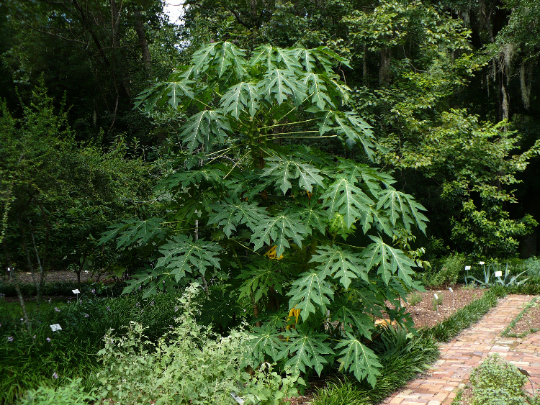Floridaseeds
Papaya Carica papaya 100 Seeds USA Company
Papaya Carica papaya 100 Seeds USA Company
Couldn't load pickup availability
Carica papaya, commonly called papaya, is a small, frost-tender, succulent, broadleaf evergreen tree that bears papaya fruits throughout the year. Each tree typically has a single, unbranched, non-woody trunk bearing the scars of old leaf bases. The trunk is topped by an umbrella-like canopy of palmately lobed leaves. Large, fleshy, melon-like fruits (papayas) hang in clusters attached to the trunk top just under the leaf canopy. Papaya typically grows to 6-20' tall (container plants to 10' tall) and is most noted for its edible melon-like fruit. It is native to lowland tropical areas of Central and South America, but is now grown in tropical to subtropical regions throughout the world both commercially and in home gardens. In the U.S., it is commercially grown in southern Florida, southern California and Hawaii. Seven lobed leaves (to 2' wide) on leaf stalks to 2-3' long are ornamentally attractive. Species plants are typically dioecious (separate male and female trees), but cultivars are hermaphroditic. Fragrant, trumpet-shaped, yellowish-white flowers bloom throughout the year, with males in long racemes and females in small clusters or solitary. Female flowers give way to smooth-skinned green fruits that ripen to yellow-orange with a yellow to pinkish-orange flesh and central cavity of pea-sized black seeds. Fruits and seeds are edible. Commercially sold fruits are typically 6-8" long and weigh about one pound, but fruits in the wild in ideal growing conditions can grow much larger with a weight of up to 20 pounds. Winter hardy to USDA Zones 10-12. This plant is intolerant of frost. It is best grown in tropical or semi-tropical climates in rich, humusy, consistently moist but well-drained organic loams in full sun. Best fruit develops in full sun. Plants tolerate light shade if grown ornamentally instead of for fruit. It can be grown in large tubs that should be overwintered indoors in bright locations.
Growing Instructions
- Prepare a mixture of half potting soil and half sand, perlite or vermiculite. Put the mixture in a pot with drainage holes in the base.
- Water the mixture so that it is moist but not wet.
- Put the seeds on the soil.
- Cover the seeds with a thin layer of soil.
- Water the seeds.
- Place the pots in an area with warm temperatures in full sun or part shade.
- When the seedlings are a few inches tall, they can be transplanted.
Materials
Materials
Shipping & Returns
Shipping & Returns
Dimensions
Dimensions
Care Instructions
Care Instructions
Share








